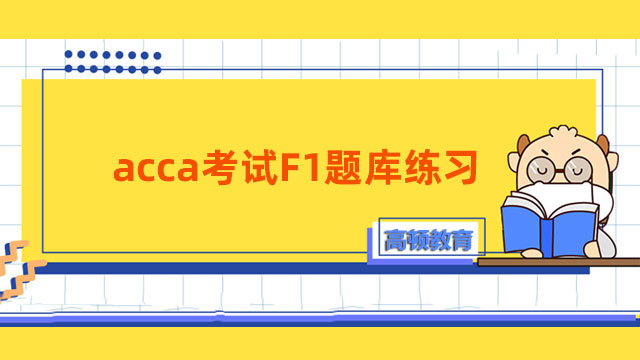2011年ACCA考试F8模拟试题(2)
Fundamentals Level – Skills Module, Paper F9
Financial Management
1 (a) Weighted average cost of capital (WACC) calculation
Cost of equity of KFP Co = 4·0 + (1·2 x (10·5 – 4·0)) = 4·0 + 7·8 = 11·8% using the capital asset pricing model
To calculate the after-tax cost of debt, linear interpolation is needed
After-tax interest payment = 100 x 0·07 x (1 – 0·3) = $4·90
Year Cash flow $ 10% discount PV ($) 5% discount PV ($)
0 Market value (94·74) 1·000 (94·74) 1·000 (94·74)
1 to 7 Interest 4·9 4·868 23·85 5·786 28·35
7 Redemption 100 0·513 51·30 0·711 71·10
––––– –––––
(19·59) 4·71
––––– –––––
After-tax cost of debt = 5 + ((10 – 5) x 4·71)/(4·71 + 19·59) = 5 + 1·0 = 6·0%
Number of shares issued by KFP Co = $15m/0·5 = 30 million shares
Market value of equity = 30m x 4·2 = $126 million
Market value of bonds issued by KFP Co = 15m x 94·74/100 = $14·211 million
Total value of company = 126 + 14·211 = $140·211 million
WACC = ((11·8 x 126) + (6·0 x 14·211))/140·211 = 11·2%
(b) (i) Price/earnings ratio method
Earnings per share of NGN = 80c per share
Price/earnings ratio of KFP Co = 8
Share price of NGN = 80 x 8 = 640c or $6·40
Number of ordinary shares of NGN = 5/0·5 = 10 million shares
Value of NGN = 6·40 x 10m = $64 million
However, it can be argued that a reduction in the applied price/earnings ratio is needed as NGN is unlisted and therefore
its shares are more difficult to buy and sell than those of a listed company such as KFP Co. If we reduce the applied
price/earnings ratio by 10% (other similar percentage reductions would be acceptable), it becomes 7·2 times and the
value of NGN would be (80/100) x 7·2 x 10m = $57·6 million
(ii) Dividend growth model
Dividend per share of NGN = 80c x 0·45 = 36c per share
Since the payout ratio has been maintained for several years, recent earnings growth is the same as recent dividend
growth, i.e. 4·5%. Assuming that this dividend growth continues in the future, the future dividend growth rate will be
4·5%.
Share price from dividend growth model = (36 x 1·045)/ (0·12 – 0·045) = 502c or $5·02
Value of NGN = 5·02 x 10m = $50·2 million
(c) A discussion of capital structure could start from recognising that equity is more expensive than debt because of the relative
risk of the two sources of finance. Equity is riskier than debt and so equity is more expensive than debt. This does not depend
on the tax efficiency of debt, since we can assume that no taxes exist. We can also assume that as a company gears up, it
replaces equity with debt. This means that the company’s capital base remains constant and its weighted average cost of
capital (WACC) is not affected by increasing investment.
The traditional view of capital structure assumes a non-linear relationship between the cost of equity and financial risk. As a
company gears up, there is initially very little increase in the cost of equity and the WACC decreases because the cost of debt
is less than the cost of equity. A point is reached, however, where the cost of equity rises at a rate that exceeds the reduction
effect of cheaper debt and the WACC starts to increase. In the traditional view, therefore, a minimum WACC exists and, as a
result, a maximum value of the company arises.
Modigliani and Miller assumed a perfect capital market and a linear relationship between the cost of equity and financial risk.
They argued that, as a company geared up, the cost of equity increased at a rate that exactly cancelled out the reduction
effect of cheaper debt. WACC was therefore constant at all levels of gearing and no optimal capital structure, where the value
of the company was at a maximum, could be found.
It was argued that the no-tax assumption made by Modigliani and Miller was unrealistic, since in the real world interest
payments were an allowable expense in calculating taxable profit and so the effective cost of debt was reduced by its tax
efficiency. They revised their model to include this tax effect and showed that, as a result, the WACC decreased in a linear
fashion as a company geared up. The value of the company increased by the value of the ‘tax shield’ and an optimal capital
structure would result by gearing up as much as possible.
It was pointed out that market imperfections associated with high levels of gearing, such as bankruptcy risk and agency costs,
would limit the extent to which a company could gear up. In practice, therefore, it appears that companies can reduce their
WACC by increasing gearing, while avoiding the financial distress that can arise at high levels of gearing.
Time allowed
Reading and planning: 15 minutes
Writing: 3 hours a
ALL FOUR questions are compulsory and MUST be attempted.
Formulae Sheet, Present Value and Annuity Tables are on
pages 6, 7 and 8.
Do NOT open this paper until instructed by the supervisor. P
During reading and planning time only the question paper may
be annotated. You must NOT write in your answer booklet until
instructed by the supervisor.
This question paper must not be removed from the examination hall.
The Association of Chartered Certified Accountants
【整理版】ACCA各科目历年真题
真题高频考点,刷题全靠这份资料
acca全科学习思维导图
梳理核心考点,一图看懂全部章节
2023年acca考纲解析
覆盖科目重难点,备考按照计划走
- acca考试怎么搭配科目?
-
建议优先选择相关联的科目进行搭配报考,这样可以提高备考效率,减轻备考压力,1、F1-F4:为随时机考科目,难度较低,这里可以自行随意选择考试顺序。2、F5-F9:如果你的工作的和财务会计或者审计有关、或者你比较擅长财务和审计的话,推荐先考F7和F8。你可以选择一起考ACCA考试科目F7和F8或者先考F7(8)再考F8(7),这就要取决你一次想考几门。3、P阶段:选修科目中,建议企业首选AFM!第二部分科目进行选择,如果AA和SBR掌握学生更好,可以通过选择AAA,如果SBL掌握的好,可以自己选择APM。
- acca一共几门几年考完?
-
acca一共有15门考试科目,其中有必修科目和选修科目,考生需要考完13门科目才能拿下证书。
- acca一年考几次?
-
acca一年有4次考试,分别是3月、6月、9月和12月,分季机考科目是采取的这类四个考季的模式,而随时机考则是没有这方面的时间规定限制,可以随报随考。
- acca的含金量如何?
-
ACCA证书的含金量是比较高的,从就业、能力提升、全球认可等角度来说,都是比较有优势的证书,其含金量主要表现在以下几个方面:1、国际化,认可度高;2、岗位多,就业前景好;3、缺口大,人才激励。
-
acca考试F1题库练习,考生必备! 2023-03-20
-
acca2022真题下载流程介绍,必做考前模考题! 2023-02-24
-
ACCA试卷出题形式?ACCA考试最快多久能通过? 2021-07-24
-
ACCA官方样题 F4(ENG) F8 2021-01-07
-
ACCA考试P1-P3模拟题及解析9 2021-01-07
-
四大会计事务所2017年终精华会评(中) 2018-02-01
-
2016年ACCA F1模拟练习题及答案 2016-02-29
-
2016年ACCA F8每日一练:Professional ethics 2016-01-26
-
2016ACCA考试F8自测题:Corporate governance 2016-01-26
-
关于ACCA考试P7中的专业和道德问题 2015-11-24
-
ACCA P5精选模拟题之战略性绩效考核 2015-10-10
-
ACCA F9模拟测试题之投资评估 2015-10-10
-
ACCA P3精选练习题之战略管理和组织变革 2015-10-10
-
2014年ACCA《公司法与商法》真题及答案七 2015-07-20
-
2014年ACCA《公司法与商法》真题及答案七 2015-07-20
-
2014年ACCA《公司法与商法》真题及答案六 2015-07-20
-
2014年ACCA《公司法与商法》真题及答案五 2015-07-20
-
2014年ACCA《公司法与商法》真题及答案四 2015-07-20
-
2014年ACCA《公司法与商法》真题及答案三 2015-07-20
-
2014年ACCA《公司法与商法》真题及答案二 2015-07-20
-
2014年ACCA《公司法与商法》真题及答案一 2015-07-20
-
2014年ACCA《公司法与商法》真题及答案八 2015-07-20
-
2015年ACCA考试模拟题 2015-06-26
-
2015年ACCA考试精选测试题汇总 2015-06-19
-
2015年ACCA考试《财务成本管理》模拟题汇总 2015-06-18
-
2015年ACCA考试F8模拟试题:Financial Management 2015-06-18
-
ACCA考试2015年《财务成本管理》模拟练习汇总 2015-04-27
-
ACCA考试2015年《财务成本管理》模拟练习5 2015-04-27
-
ACCA考试2015年《财务成本管理》模拟练习4 2015-04-27
 更多服务
更多服务

















